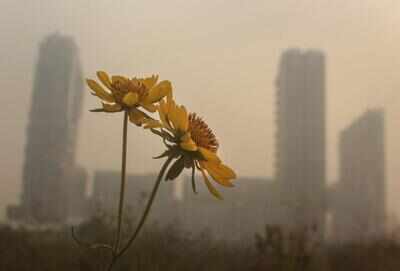- News
- City News
- gurgaon News
- Gurgaon’s pollution level ‘severe’ for the second day in a row
Gurgaon’s pollution level ‘severe’ for the second day in a row
Gurgaon’s pollution level ‘severe’ for the second day in a row

Flowers bloom against the backdrop of buildings engulfed by thick haze in Gurgaon, which recorded an AQI of 456 on Saturday
Gurgaon: A thick blanket of smog continued to engulf the city as the 24-hour average air quality index (AQI) across several monitoring stations was recorded at the ‘severe’ category for the second consecutive day on Saturday. The air quality, however, improved slightly due to higher wind speed and is expected to further flush out pollutants from Sunday onwards, weather experts said.
According to Central Pollution Control Board’s (CPCB), the city’s air quality index (AQI) stood at 456 on Saturday. Due to rampant bursting of crackers on Diwali on Thursday despite restrictions, coupled with a rise in incidents of stubble burning, the city’s AQI had slipped to the ‘severe’ category to reach 472 on Friday. An AQI between 401 and 500 is considered ‘severe’.
On Saturday, Vikas Sadan, Sector 51 and Teri Gram air monitoring stations recorded AQIs at 492, 499 and 419, respectively. Statistics for the Gwal Pahari centre was not available because of insufficient data.
The Haryana State Pollution Control Board (HSPCB), however, predicted that the pollutants would clear out of the city’s air as wind speed had picked up since Saturday evening. On Saturday, the average speed was recorded at six kilometres per hour (km/hr), up from the three km/hr a day ago.
Besides calm winds, unfavourable weather conditions like low temperature and low mixing height had also degraded the city’s air quality over the last few days, experts said. According to India Meteorological Department (IMD), Gurgaon’s minimum temperature was recorded at 16 degrees Celsius and maximum at 26.2 degrees on Saturday.
Anumita Roychowdhury, executive director, research and advocacy at CSE, meanwhile, told TOI that stubble burning had also added to Gurgaon’s air pollution.
“We do not have any mechanism in place to check the contribution of stubble burning share in Gurgaon’s air quality at the moment, but of course it is affecting the district’s AQI as we have data that it is clearly impacting Delhi’s air,” Roychowdhury said. The civic authorities, meanwhile, said they have upped pollution mitigation measures by sprinkling water on roads and continuing night patrolling. “We have urged corporates and RWAs to start sprinkling water across Gurgaon,” Kuldeep Singh, HSPCB regional officer, said.
Delhi’s air quality may see an improvement, too, with IMD forecasting strong surface winds at 20-30 kmph on Sunday. System of Air Quality and Weather Forecasting And Research (SAFAR), a pollution monitoring body under the Union ministry of earth sciences, said, “Delhi’s AQI is likely to improve to upper end of ‘very poor’ category as surface winds are becoming stronger, dispersing air pollutants. Strong north-westerly winds enhance transport of emissions from stubble burning. Share of crop residue burning emissions in PM2.5 is 41% (Effective fire count 5,159).” The CPCB’s central control room data showed that Delhi-NCR's average 24-hour PM10 and PM2.5 concentrations were 429 micrograms per cubic metre and 298 micrograms per cubic metre, respectively, at 7pm.
According to Central Pollution Control Board’s (CPCB), the city’s air quality index (AQI) stood at 456 on Saturday. Due to rampant bursting of crackers on Diwali on Thursday despite restrictions, coupled with a rise in incidents of stubble burning, the city’s AQI had slipped to the ‘severe’ category to reach 472 on Friday. An AQI between 401 and 500 is considered ‘severe’.
On Saturday, Vikas Sadan, Sector 51 and Teri Gram air monitoring stations recorded AQIs at 492, 499 and 419, respectively. Statistics for the Gwal Pahari centre was not available because of insufficient data.
The Haryana State Pollution Control Board (HSPCB), however, predicted that the pollutants would clear out of the city’s air as wind speed had picked up since Saturday evening. On Saturday, the average speed was recorded at six kilometres per hour (km/hr), up from the three km/hr a day ago.
Besides calm winds, unfavourable weather conditions like low temperature and low mixing height had also degraded the city’s air quality over the last few days, experts said. According to India Meteorological Department (IMD), Gurgaon’s minimum temperature was recorded at 16 degrees Celsius and maximum at 26.2 degrees on Saturday.
Anumita Roychowdhury, executive director, research and advocacy at CSE, meanwhile, told TOI that stubble burning had also added to Gurgaon’s air pollution.
“We do not have any mechanism in place to check the contribution of stubble burning share in Gurgaon’s air quality at the moment, but of course it is affecting the district’s AQI as we have data that it is clearly impacting Delhi’s air,” Roychowdhury said. The civic authorities, meanwhile, said they have upped pollution mitigation measures by sprinkling water on roads and continuing night patrolling. “We have urged corporates and RWAs to start sprinkling water across Gurgaon,” Kuldeep Singh, HSPCB regional officer, said.
Delhi’s air quality may see an improvement, too, with IMD forecasting strong surface winds at 20-30 kmph on Sunday. System of Air Quality and Weather Forecasting And Research (SAFAR), a pollution monitoring body under the Union ministry of earth sciences, said, “Delhi’s AQI is likely to improve to upper end of ‘very poor’ category as surface winds are becoming stronger, dispersing air pollutants. Strong north-westerly winds enhance transport of emissions from stubble burning. Share of crop residue burning emissions in PM2.5 is 41% (Effective fire count 5,159).” The CPCB’s central control room data showed that Delhi-NCR's average 24-hour PM10 and PM2.5 concentrations were 429 micrograms per cubic metre and 298 micrograms per cubic metre, respectively, at 7pm.
FacebookTwitterLinkedinEMail
Start a Conversation
end of article
Quick Links
Delhi Air PollutionDelhi TemperatureChennai WeatherBangalore TemperatureCovid vaccination centres in DelhiCoronavirus in DelhiRTPCR test in GurgaonHyderabad RainPollution level in BangaloreDelhi SmogDelhi TemperatureNoida AQIGurgaon AQI todayFire in MumbaiMumbai RainsCovid 19 RT PCR Test in NoidaDelhi AQI todaySrinagar encounter

